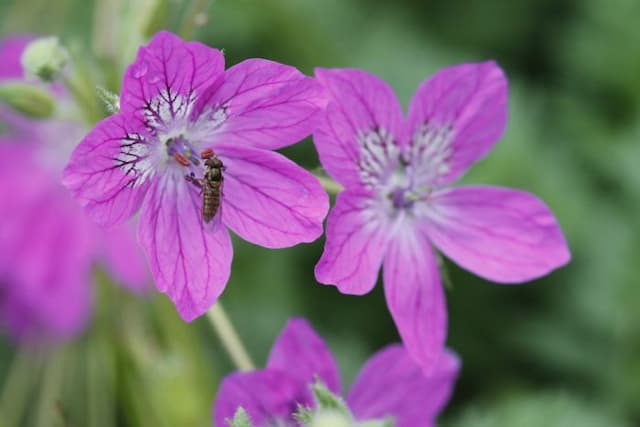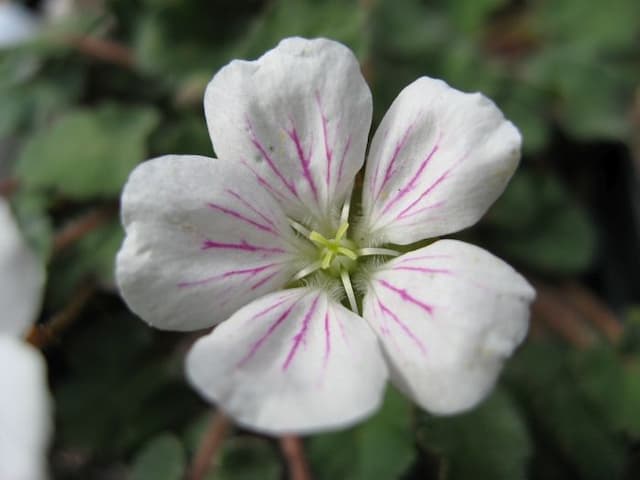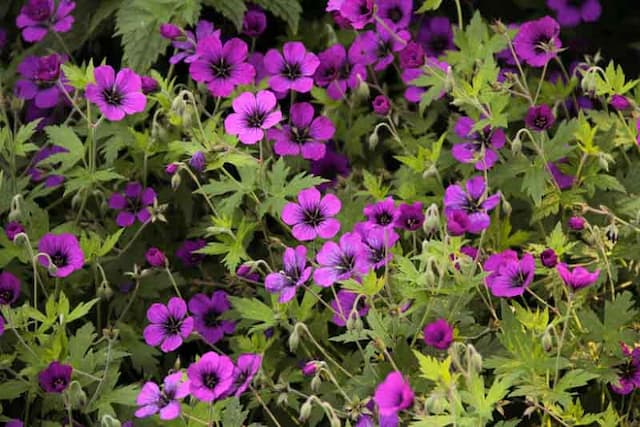Purple Cranesbill Geranium × magnificum 'Alan Mayes'

ABOUT
The Geranium × magnificum 'Alan Mayes' is a striking perennial variety known for its showy flowers and attractive foliage. The plant bears vibrant violet-blue blooms that are rounded in shape, with distinct veining on the petals adding texture and interest. These flowers are grouped tightly together, forming clusters that provide a bold splash of color in the garden. The center of each flower features tiny, lighter-colored stamens which contrast with the deep tones of the petals. Surrounding the flowers, the foliage consists of large, lush leaves with a kidney to rounded shape. The leaves are deeply lobed and have an almost serrated edge, giving them a somewhat lacy appearance. The green of the leaves is a rich, verdant shade that serves as the perfect backdrop to highlight the bright flowers. Throughout its blooming period, the Geranium × magnificum 'Alan Mayes' presents an impressive display, with the mass of flowers often completely covering the plant's lush leaves, creating a dense mound of floral beauty. This particular variety is known for its robust nature and the long-lasting nature of its blossoms. The striking contrast of the vibrant violet-blue petals with the fresh green foliage makes it a favorite among gardeners looking for a plant that provides visual impact.
About this plant
 Names
NamesSynonyms
Purple Cranesbill, Showy Geranium, Magnificent Cranesbill
Common names
Geranium × magnificum 'Alan Mayes'.
 Toxicity
ToxicityTo humans
The plant commonly known as cranesbill is not known to be toxic to humans. Generally, cranesbills are considered safe and there are no known significant toxic effects from ingesting parts of this plant.
To pets
The plant commonly referred to as cranesbill is also not known to be toxic to pets. It is generally considered non-toxic to dogs, cats, and other animals, and there should be no symptoms of poisoning from ingestion of this plant.
 Characteristics
CharacteristicsLife cycle
Perennials
Foliage type
Deciduous
Color of leaves
Green
Flower color
Violet-blue
Height
1-2 feet (30-60 cm)
Spread
1-2 feet (30-60 cm)
Plant type
Herb
Hardiness zones
5
Native area
Caucasus
Benefits
 General Benefits
General Benefits- Attracts pollinators: Geranium × magnificum 'Alan Mayes' is known for its ability to attract bees and butterflies, which are essential for pollination in the garden.
- Aesthetic appeal: With its striking violet-blue flowers, this cranesbill provides a vibrant splash of color that enhances the visual appeal of any garden space.
- Low maintenance: The plant is relatively easy to care for, requiring minimal attention once established in the right conditions.
- Drought tolerance: Once established, it can tolerate periods of dryness, making it suitable for gardens in regions with water restrictions or limited rainfall.
- Seasonal interest: It offers seasonal interest from late spring to early summer with its lush blooms and attractive foliage that often turns red in the fall.
- Weed suppression: The dense foliage can help to suppress weeds, reducing the need for manual weeding and the use of herbicides in the garden.
- Long-lived: It is a hardy, perennial plant that can live for many years, offering a long-term presence in the garden.
 Medical Properties
Medical PropertiesThis plant is not used for medical purposes.
 Air-purifying Qualities
Air-purifying QualitiesThis plant is not specifically known for air purifying qualities.
 Other Uses
Other Uses- Geranium leaves can be infused in water to make a fragrant rinse for linens or delicate clothing. The leaves impart a gentle, fresh scent.
- The crushed leaves of Geranium can be rubbed onto wooden furniture as a natural polish and to leave a pleasant aroma.
- Dried Geranium flowers can be added to homemade potpourri mixtures, contributing to the visual appeal and fragrance.
- Fresh Geranium petals can be used as a colorful and edible garnish for salads, desserts, and drinks.
- The vibrant colors of Geranium flowers are used to make natural dyes for fabric or paper crafts.
- Geranium leaves can be placed in a sachet to deter moths and freshen up closets and drawers.
- Geranium blossoms can be crystalized with sugar and used as decorative and edible elements in baking.
- Used as a natural insect repellent, Geranium leaves can be rubbed on the skin or infused in sprays to ward off mosquitoes and other bugs.
- The plant can be positioned in garden beds as a companion plant to help repel pests from vulnerable vegetables or herbs.
- When included in compost, Geranium trimmings can contribute to the overall health of the compost mixture with their nutrient-rich foliage.
Interesting Facts
 Feng Shui
Feng ShuiThe Hardy Geranium is not used in Feng Shui practice.
 Zodiac Sign Compitability
Zodiac Sign CompitabilityThe Hardy Geranium is not used in astrology practice.
 Plant Symbolism
Plant Symbolism- Unity and True Friendship: Geraniums in general symbolize unity and true friendship, suggesting a bond that is both affectionate and steadfast. The 'Alan Mayes' variety, with its striking presence, might be seen as an emblem of enduring camaraderie.
- Good Health: Historically, geraniums have been associated with good health and the restoration of physical, emotional, and spiritual well-being. 'Alan Mayes', with its robust and vivacious nature, encompasses this meaning.
- Happiness and Positive Emotions: The bright and vibrant flowers of the 'Alan Mayes' geranium are often linked to happiness, cheerfulness, and positive emotions, exemplifying the joy that can be found in the natural world.
- Fertility and Abundance: Some cultures see geraniums as a symbol of fertility and abundance, which aligns with the 'Alan Mayes' variety's lush and prolific blooming habits.
 Water
WaterHardy geraniums, including the Geranium × magnificum 'Alan Mayes', prefer even moisture but also well-drained soil to prevent root rot. Water the plant deeply once a week, providing about 1 to 1.5 gallons of water per square yard of soil. During hot or dry periods, increase watering frequency to maintain consistent soil moisture. In cooler temperatures or rainy weather, reduce the amount of water to prevent over-watering. Always check the top inch of the soil; if it feels dry, it's time to water.
 Light
LightThe Geranium × magnificum 'Alan Mayes', commonly known as the Showy Geranium, thrives best in full sun to part shade. A location that receives morning sunlight and afternoon shade would be ideal to protect it from the intense heat of the midday sun. However, it can also tolerate full sun if not in an excessively hot climate.
 Temperature
TemperatureThe Showy Geranium can withstand a range of temperatures and is quite hardy. It prefers temperatures between 65°F and 75°F but can survive in temperatures as low as 20°F and as high as 85°F. Avoid exposing the plant to extreme heat or frost, which may damage the foliage and flowers.
 Pruning
PruningPruning the Showy Geranium should be done to remove dead or faded flowers and to encourage bushier growth. Prune the plant lightly after the first wave of flowering to promote a second bloom. The best time for major pruning is in early spring or after the plant has finished flowering in fall.
 Cleaning
CleaningAs needed
 Soil
SoilThe best soil mix for the Cranesbill 'Alan Mayes' is well-draining soil enriched with organic matter. The soil pH should be neutral to slightly alkaline, ranging from 6.5 to 7.5.
 Repotting
RepottingCranesbill 'Alan Mayes' does not require frequent repotting; it is typically done every 3-4 years or when it has outgrown its current container.
 Humidity & Misting
Humidity & MistingCranesbill 'Alan Mayes' is adaptable and does not require specific humidity conditions; average room humidity is generally sufficient.
 Suitable locations
Suitable locationsIndoor
Ensure bright light, well-draining soil, and regular watering for Cranesbill.
Outdoor
Choose partial shade, moist soil, and protect from extreme cold for Cranesbill.
Hardiness zone
4-8 USDA
 Life cycle
Life cycleGeranium × magnificum, commonly known as the Purple Cranesbill, begins its life cycle with seed germination, typically in the spring when the soil warms up. The seedlings then establish a robust root system and grow into compact clumps, developing deeply lobed leaves. As the plant matures, it enters the vegetative stage, becoming bushier and producing more leaves, and prepares for the flowering stage. Throughout late spring to early summer, the Purple Cranesbill enters the reproductive phase, producing striking purple flowers that attract pollinators and subsequently may result in seed formation if conditions are favorable. After flowering, the plant may enter a period of dormancy, especially in regions with cold winters, where the above-ground part dies back and the plant survives with its roots underground. In the following spring, the plant regrows from its rootstock, continuing its perennial cycle.
 Propogation
PropogationPropogation time
Spring-Early Summer
Geranium × magnificum 'Alan Mayes', commonly known as Hardy Geranium or Crane's-bill, is often propagated by division, a straightforward and reliable method. The best time for dividing this perennial plant is either in the spring as new growth appears or in the autumn, after flowering has ceased and the plant begins to go dormant. To propagate by division, carefully dig around the plant to lift it from the soil. Gently separate the plant into smaller clumps, ensuring each clump has a good amount of roots and shoots. These divisions can then be immediately replanted in well-prepared soil, spaced at least 12 inches (about 30 centimeters) apart to allow for growth. The divisions should be watered thoroughly after planting to facilitate root establishment.









![Cranesbill [Rothbury Gem]](/_next/image?url=https%3A%2F%2Fplants-admin.emdemapps.com%2Fimages%2Fplants%2F%2Fimages%2F604b6243984c2.png&w=640&q=75)